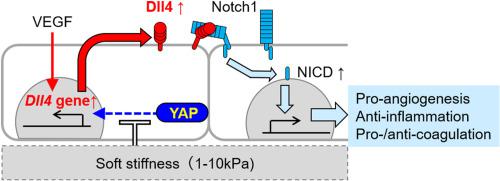Experimental Cell Research ( IF 3.3 ) Pub Date : 2021-09-17 , DOI: 10.1016/j.yexcr.2021.112835 Eri Matsuo 1 , Takayuki Okamoto 2 , Atsushi Ito 3 , Eiji Kawamoto 4 , Kunihiro Asanuma 5 , Koichiro Wada 2 , Motomu Shimaoka 6 , Motoshi Takao 3 , Akira Shimamoto 3

|
Endothelial cells adapt their functions as a consequence of sensing extracellular substrate stiffness; these alterations allow them to maintain their vascular structure and function. Substrate stiffness-mediated yes-associated protein 1 (YAP) activation plays an important role in mechano-transduction and pro-angiogenic phenotype of endothelial cells, and Delta-like ligand 4 (Dll4)-Notch1 signaling is closely related to angiogenesis; however, the impact of substrate stiffness-mediated interrelation of these pathways on endothelial cell functions remains elusive. We confirmed that endothelial cells on softer substrates not only elongate cellular aspects but also attenuate YAP activation compared to cells on stiffer substrates. Endothelial cells on softer substrates also upregulate the vascular endothelial growth factor receptor 1 (VEGFR1) and VEGFR2 mRNA expression that is enhanced by VEGF stimulation. We determined that endothelial cells on softer substrates increased Dll4 expression, but not Notch1 expression, via YAP signaling. Moreover, endothelial cells on soft substrates induced not only VEGFRs upregulation but also suppression of pro-inflammatory interleukin-6 and plasminogen activator inhibitor-1 mRNA expression and the facilitation of anti-coagulant thrombomodulin and pro-coagulant tissue factor mRNA expression. Our results suggest that endothelial cells activate the YAP-Dll4-Notch signaling pathway in response to substrate stiffness and dictate cellular function.
中文翻译:

底物刚度通过 YAP-Dll4-Notch1 通路调节内皮细胞功能
作为感知细胞外基质硬度的结果,内皮细胞调整其功能;这些改变使它们能够维持其血管结构和功能。底物刚度介导的 yes 相关蛋白 1 (YAP) 激活在内皮细胞的机械转导和促血管生成表型中起重要作用,Delta 样配体 4 (Dll4)-Notch1 信号传导与血管生成密切相关;然而,这些途径的基质刚度介导的相互关系对内皮细胞功能的影响仍然难以捉摸。我们证实,与较硬基质上的细胞相比,较软基质上的内皮细胞不仅延长了细胞方面,而且还减弱了 YAP 激活。软基质上的内皮细胞也会上调血管内皮生长因子受体 1 (VEGFR1) 和 VEGFR2 mRNA 的表达,这会因 VEGF 刺激而增强。我们确定软底物上的内皮细胞通过 YAP 信号传导增加了 Dll4 表达,但不增加 Notch1 表达。此外,软基质上的内皮细胞不仅诱导 VEGFR 上调,而且还抑制促炎性白细胞介素 6 和纤溶酶原激活剂抑制剂 1 mRNA 的表达,促进抗凝血栓调节蛋白和促凝组织因子 mRNA 的表达。我们的结果表明,内皮细胞激活 YAP-Dll4-Notch 信号通路以响应底物刚度并决定细胞功能。我们确定软底物上的内皮细胞通过 YAP 信号传导增加了 Dll4 表达,但不增加 Notch1 表达。此外,软基质上的内皮细胞不仅诱导 VEGFR 上调,而且还抑制促炎性白细胞介素 6 和纤溶酶原激活剂抑制剂 1 mRNA 的表达,促进抗凝血栓调节蛋白和促凝组织因子 mRNA 的表达。我们的结果表明,内皮细胞激活 YAP-Dll4-Notch 信号通路以响应底物刚度并决定细胞功能。我们确定软底物上的内皮细胞通过 YAP 信号传导增加了 Dll4 表达,但不增加 Notch1 表达。此外,软基质上的内皮细胞不仅诱导 VEGFR 上调,而且还抑制促炎性白细胞介素 6 和纤溶酶原激活剂抑制剂 1 mRNA 的表达,促进抗凝血栓调节蛋白和促凝组织因子 mRNA 的表达。我们的结果表明,内皮细胞激活 YAP-Dll4-Notch 信号通路以响应底物刚度并决定细胞功能。软基质上的内皮细胞不仅诱导 VEGFR 上调,而且还抑制促炎性白细胞介素 6 和纤溶酶原激活剂抑制剂 1 mRNA 的表达,并促进抗凝血栓调节蛋白和促凝组织因子 mRNA 的表达。我们的结果表明,内皮细胞激活 YAP-Dll4-Notch 信号通路以响应底物刚度并决定细胞功能。软基质上的内皮细胞不仅诱导 VEGFR 上调,而且还抑制促炎性白细胞介素 6 和纤溶酶原激活剂抑制剂 1 mRNA 的表达,并促进抗凝血栓调节蛋白和促凝组织因子 mRNA 的表达。我们的结果表明,内皮细胞激活 YAP-Dll4-Notch 信号通路以响应底物刚度并决定细胞功能。











































 京公网安备 11010802027423号
京公网安备 11010802027423号